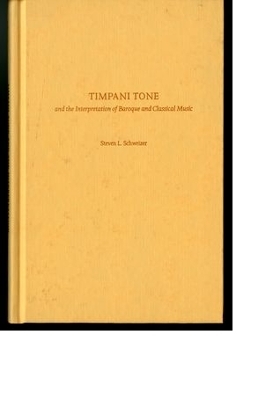
Timpani Tone and the Interpretation of Baroque and Classical Music
Oxford University Press Inc (Verlag)
978-0-19-539555-6 (ISBN)
Timpani Tone and the Interpretation of Baroque and Classical Music explores the nature, production, and evolution of timpani tone and provides insights into how to interpret the music of J. S. Bach, Handel, Haydn, and Mozart. In drawing on 31 years of experience, Steven L. Schweizer focuses on the components of timpani tone and methods for producing it. In so doing, he discusses the importance of timpani bowl type; mallets; playing style; physical gestures; choice of drums; mallet grip; legato, marcato, and staccato strokes; playing different parts of the timpano head; and psychological openness to the music in effectively shaping and coloring timpani parts.
In an acclaimed chapter on interpretation, Schweizer explores how timpanists can use knowledge of the composer's style, psychology, and musical intentions; phrasing and articulation; the musical score; and a conductor's gestures to effectively and convincingly play a part with emotional dynamism and power. The greater part of the book is devoted to the interpretation of Baroque and Classical orchestral and choral music. Meticulously drawing on original sources and authoritative scores from the seventeenth through nineteenth centuries, Schweizer convincingly demonstrates that timpanists were capable of producing a broader range of timpani tone earlier than is normally supposed. The increase in timpani size, covered timpani mallets, and thinner timpani heads increased the quality of timpani tone; therefore, today's timpanist's need not be entirely concerned with playing with very articulate sticks. In exhaustive sections on Bach, Handel, Haydn, and Mozart, Schweizer takes the reader on an odyssey through the interpretation of their symphonic and choral music.
Relying on Baroque and Classical performance practices, timpani notation, the composer's musical style, and definitive scores, he interprets timpani parts from major works of these composers. Schweizer pays particular attention to timpani tone, articulation, phrasing, and dynamic contouring: elements necessary to effectively communicate their part to listeners.
Steven L. Schweizer has served as timpanist with the Topeka Symphony and Florence [SC] Symphony Orchestras. He is Associate Professor and Program Coordinator of the Political Science Department at Newberry College.
SYMBOLS AND MARKINGS; ABOUT THE COMPANION WEBSITE; THE TIMPANI; ACOUSTICS OF THE TIMPANI; TIMPANI MALLETS; PLAYING STYLE; TIMPANI HEADS; PLAYING THE HEAD; PLAYING THE HEAD: TECHNIQUES; CHANGING TONE BY CHANGING THE GRIP; STICK SELECTION AND TONE PRODUCTION; USING PHYSICAL GESTURES TO COLOR TONE; CHOICE OF DRUMS; PLAYING IN AND AROUND THE PLAYING SPOT; TONE PRODUCING STROKES; THE GRIP; PSYCHOLOGICAL OPENNESS TO MUSIC; THE THEORY OF CONTRAST; CONCLUSION; THE COMPOSER'S STYLE, PSYCHOLOGY, AND INTENTIONS; PHRASING AND ARTICULATION; CREATING EMOTION; AIDS IN INTERPRETING MUSIC; TIMPANI, MALLETS AND TONE IN THE BAROQUE AND CLASSSICAL ERAS; TECHNICAL CONSIDERATIONS IN INTERPRETING BAROQUE MUSIC (1650-1750); HENRY PURCELL AND JOHANN SEBASTIAN BACH; GEORGE FRIDERIC HANDEL
| Erscheint lt. Verlag | 22.7.2010 |
|---|---|
| Zusatzinfo | 13 photographs, 92 musical examples |
| Verlagsort | New York |
| Sprache | englisch |
| Maße | 236 x 155 mm |
| Gewicht | 431 g |
| Themenwelt | Kunst / Musik / Theater ► Musik ► Instrumentenkunde |
| Kunst / Musik / Theater ► Musik ► Klassik / Oper / Musical | |
| ISBN-10 | 0-19-539555-7 / 0195395557 |
| ISBN-13 | 978-0-19-539555-6 / 9780195395556 |
| Zustand | Neuware |
| Informationen gemäß Produktsicherheitsverordnung (GPSR) | |
| Haben Sie eine Frage zum Produkt? |
aus dem Bereich


